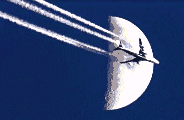Contrails ! Rotax reduction gear
Rare pictures
The element that makes a difference on the Rotax 9XX engines, is the reduction gear. Some are afraid of it, others consider it trouble free, but very few of us have actually seen what it looks like inside.
Bob Borger attended the Rotax seminar at Lockwood Aviation. The following pictures are published here with his kind permission.
Gear reduction secrets
The heart of the gearbox
In a four-cylinder engine gear reduction unit, particular attention must be paid to torque variations.
The Rotax 9XX reduction gearbox is of the spur type, with dog axial shock absorber, and an optional overload clutch.
Dean Vogel from Lockwood Aviation, presents the two primary gears. Small one from the crankshaft. The big one from the gear box.
Please note the light on the big gear dogs.
Those two gears are a paired set, and have a single 6-digit Rotax serial number.
Do not mix gears from two sources !
Removing the gearbox
The gearbox is attached to the crankcase by 8 Allen M6 and 2 Allen M8 screws, and kept in position by two 6×20 dowels.
Pulling the gear case necessitates some persuasion and an impact tool screwed into the two gearbox nose bosses.
Of course, it usually doesn't take five people to do the job !
Crankcase
Crankcase and gearbox rear plate. Note the sturdy crankcase ribs.
One can make out a closing plate above the roller bearing, indicating the absence of a vacuum pump drive.
The two dowels must remain with the crankcase and not with the gear cover.
Drive gear nut
Notice the notches cut in the edges between the flats of the big nut. It is a Left-Hand thread.
Nut dimensions M 30/1.5, wrench 41 mm.
The center channel brings high pressure oil to the crank backing bearing in the gear cover.
Magnetic plug
The magnetic plug viewed from inside.
Please note the oil holes. The drive gear is nearly immersed in oil when at rest. It spins clockwise on this picture.
Oil collected by the oil baffle (Cf next §) flows to the lower left onto the drive gear and is thrown between the two gears.
Also of interest, the view of the prop shaft roller bearing circlip.
Gearbox
The small gear on the propeller shaft, is the vacuum pump drive gear, mounted here even when the pump gear is not installed.
Please note the oil baffle at the bottom right. It collects the oil thrown by the big gear, to bring it to the crankshaft pinion, just where the two gears engage each other.
Clearly this lubrication system can't work in knife-egdge or inverted flight : the Rotax 9XX are not designed for aerobatics.
"Dog" gear
Propeller dog gear and shaft.
One can make out the pink crankshaft bush, pressure lubricated via the central bore in the crankshaft.
Two versions
Examples of the Zero degree dog hub (left) and 30 degree dog hub with slipper clutch (right).
The dog is now integral with the propeller gear.
Slipper clutch
Behind the big dog gear, the overload or slipper clutch, very similar to a motorcycle multi-plate clutch.
The overload clutch consists of a stack of drive plates 1 and 1.8 mm thick, alternatively meshing with the clutch drum and hub (1, 2) driving the propeller shaft, and the dog hub (4) engaging the big reduction gear.
The assembly is pressed by the pressure ring (7) and the two Belleville springs (8), enclosed inside the screw cover (9) screwed onto the drum.
Detail of the overload clutch with dog hub removed.
Please note the 1.8 mm sinterized disk (6) internal teeth, engaging the dog hub external splines.
In the center, the clutch hub (2), with internal splines to mesh with the propeller shaft.
At the bottom, the bronze pink friction 45.2/60/1 washer (3).
In case of overtorque, the assembly allows some degree of slip between the propeller shaft and the big gear driven by the engine.
The empty gear case. There only remains the propeller shaft with its drive splines.
The aperture above the ball bearing is for the mechanical fuel pump.
To learn more
The Rotax 91X seminar
 The complete story by Bob Borger
The complete story by Bob Borger
 Email the author
Email the author


















